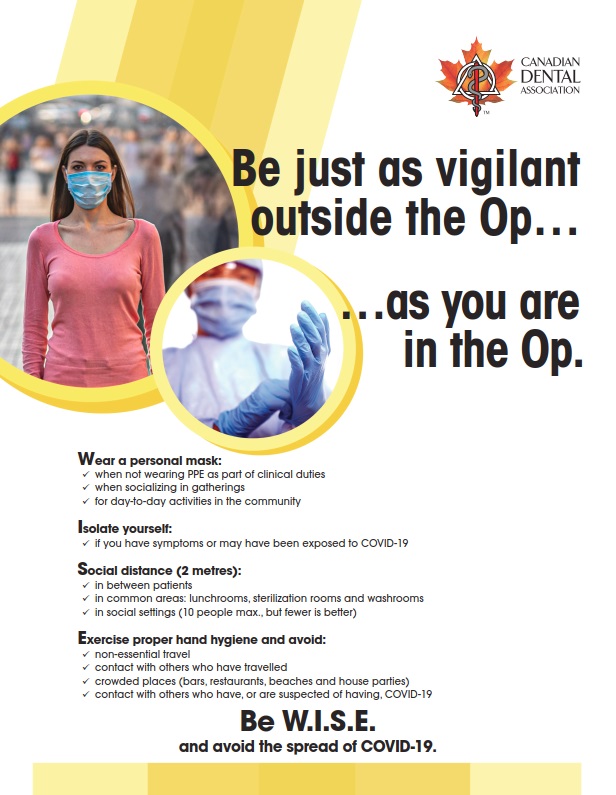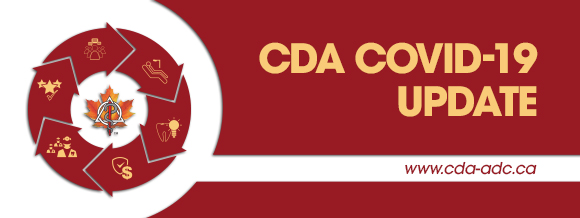Quick Facts: Current COVID-19 Situational Report
Dr. Aaron Burry, CDA’s COVID-19 Team Lead and Deputy CEO - Professional Affairs, provides a video update on the COVID-19 pandemic to the Presidents and CEOs of CDA’s Corporate Member provincial dental associations.

Video Length: 26 minutes. Recorded: January 11, 2022.
|
Video highlights:
Global fast facts: Omicron Outbreak
- Worldwide, the reported COVID-19 case count has risen from a low of approximately 3 million in October 2021 to 18 million in the last 7 days (January 2022).
- The Omicron variant now dominates case counts in Ontario and Quebec, representing over 98% of all confirmed tests.
- The explosive spread of the Omicron variant means that previous measures to contain the virus are no longer working. Contact tracing is largely ineffective and many cases are of unknown origin.
- Omicron is associated more with upper respiratory tract illness rather than in the lungs, which results in less severe illness than previous strains.
- Double vaccination (and boosters) remains very effective against Omicron.
- Work forces are being impacted significantly by the rise in case numbers, with absentee rates of 20% to 40% across all sectors. There is a risk that a similar pattern will affect dental offices.
- In recent weeks, Canada’s death rate has been around 6 deaths per 100,000. Hospitalizations and ICU numbers are somewhat elevated but not close to capacity.
- The Omicron variant is a setback; however, the overall pandemic outlook remains promising and is on track to be more under control by the end of 2022.
Public Health Messaging and Responses: Public health messaging across Canada is not consistent. There are limits to what public health can do with regards to traceable contacts and cluster outbreaks. Most regions are experiencing many community outbreaks of unknown origin which is leading to increases in local restrictions. Significant case increases at the provincial level are leading to the reintroduction of measures such as school closures.
Public health messaging in relation to vaccines has been particularly complex and challenging across Canada. This is because vaccines do not prevent infection completely, nor do they fully prevent illness. The purpose of the vaccination program is to maintain the capacity of the health care system and to prevent high levels of hospitalizations and death. This is a complex message to convey to the public.
Areas of Focus and Reminders for Dentists:
Community spread: High levels of community transmission means that the extent of transmission is unknown in most communities. The likelihood of patients coming to the dental office with COVID-19 is much higher than it has been in previous weeks.
Travel: Travel outside of Canada is not recommended at this time. Return travel is unpredictable, stressful and the number of cancelled flights has increased. There is also a higher risk associated with air travel within Canada than in previous weeks and some provinces have introduced quarantine requirements for individuals traveling into a province.
IPAC: It is recommended that infection prevention and control measures in the dental office be elevated to the highest level for the next several weeks. Typical considerations include:
- full vaccination (and boosters) for all dentists and staff; and
- the use of N95 respirators when in contact with patients and using full eye protection.
High risk patient groups: Dentists should be aware that patients who at greater risk from COVID-19 include:
- children under age 5;
- unvaccinated children;
- pregnant women (particularly if unvaccinated); and
- individuals with complex medical conditions.
Hand and surface sanitization: Influenza, the common cold and COVID-19 are circulating within the community simultaneously. Heightened hand and surface hygiene is strongly recommended.
Patient bookings: Separating patients can be an effective method in reducing transmission within the dental office. Para influenza, influenza and RSV infections are likely to impact dental practices and trigger the need to reschedule patients who are showing COVID-like symptoms.
Vaccination status: Consider monitoring the vaccination status of patients who are more than 6 months since their last dose.
Vigilance: Dental office staff must remain hyper vigilant in their personal lives, when presenting to the office for work, and when in non-clinical/common areas inside the office. Corporate Member Provincial Dental Associations (PDAs) are encouraged to continue promoting the “Being Vigilant Inside and Outside the Op!” poster series to member dentists, as deemed appropriate.

A preview of one poster in CDA’s Be Vigilant Inside and Outside the Op! series.
Colours and text may vary as Corporate Member provincial dental associations may have adapted the materials for use by their member dentists. Dentists should be encouraged to use the posters and to discuss the importance of being vigilant with their staff.
|
|
